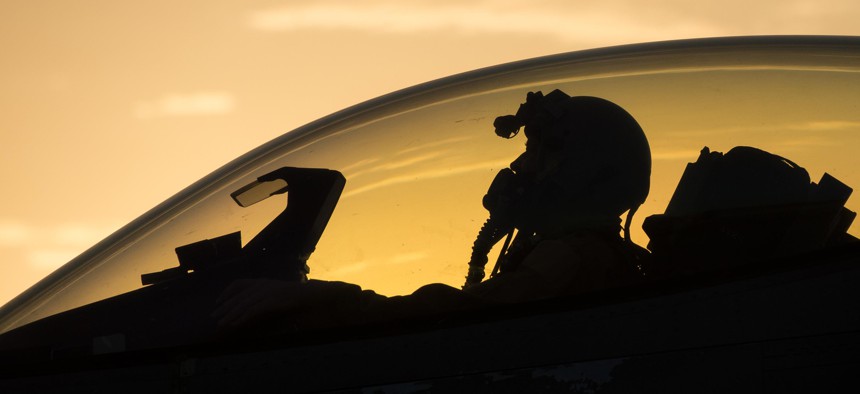
At Bagram Air Base, Afghanistan, a U.S. Air Force F-16 Fighting Falcon “Triple Nickel” aircraft pilot assigned to the 555th Expeditionary Fighter Squadron from Aviano Air Base, Italy, awaits weapons check, July 14, 2015. U.S. Air Force photo by Tech. Sgt. Joseph Swafford/Released
The US Air Force Is Short 700 Fighter Pilots. Here’s Our Plan to Fix That.
Busier but smaller than ever, the Air Force needs higher bonuses and more family time to help compete with commercial airlines and the economy.
In our time in various leadership positions at the Pentagon, we’ve learned many important lessons. One of those might not seem so obvious: What is good for the U.S. economy sometimes creates very real challenges for our all-volunteer military. Low unemployment and hiring booms, while beneficial to the country, often make it very difficult for the armed services to recruit and retain talent.
A case in point is the growing shortage of fighter pilots. That shortfall is expected to grow from 500 to more than 700 pilots by the end of this fiscal year, a 21-percent gap between what we have and what we need to meet the requirements of our commanders around the world. It is a significant deficit and one that has gotten our closest attention. And the Air Force is not alone. The Navy and Marine Corps are facing parallel challenges as the commercial airline industry embarks on a prolonged hiring wave fueled by many of its senior pilots hitting mandatory retirement age. Add to that a recent change in requirements that new commercial airline pilots have 1,500 flight hours under their belts, and suddenly military-trained pilots become even more attractive than usual.
Aside from an airline hiring surge, there are other reasons for the Air Force’s pilot shortfall, from dramatically reduced flying hours for the high-end fight as a result of Pentagon budget cuts to a perceived falloff in quality of life when they return from deployments overseas. Make no mistake, this is a quiet crisis that will almost certainly get worse before it gets better.
Our charge as leaders is to meet this challenge head on, with practical, common sense solutions that attack the root causes and give our Airmen compelling reasons to stay. Our military pilots, just like their commercial aviation counterparts, are essential to ensuring that our nation’s defense and commerce stay strong.
REGISTER NOW: Defense One Leadership Briefing with Deborah Lee James, July 26, 2016, The Watergate
The Air Force has faced fighter pilot shortages before – often related to cyclical hiring peaks in the private sector – but this one has the potential to be more damaging. After 25 years of continuous combat, the Air Force is as busy as we have ever been, but we are also smaller than we have ever been. Consequently, we have less margin for error when it comes to filling our cockpits and addressing personnel shortages. Unlike many private-sector companies, which can fill vacancies by simply tapping an experienced and flexible labor pool, the military has to grow its own set of skilled specialists, and that can take years.
With that in mind, we are moving aggressively to reverse the trends and improve pilot retention. We are ramping up the production of new pilots, working to get help for fighter squadrons burdened with time-consuming administrative duties and looking closely at additional compensation. Congress has heard the alarm bells and there is a proposal on Capitol Hill right now that would increase the annual bonus given to mid-career pilots who choose to remain in uniform. The current annual bonus offered to pilots of manned aircraft – $25,000 per year – has not changed since 1999 and its value has been impacted by inflation.
We know from past experience that money isn’t everything, but in those military career fields lured by private sector offers, targeted bonuses can make the difference between staying or going. Right now, too few of our pilots are taking the bonus money and the “take rate” is especially low for those men and women who fly fighter aircraft. We’d like the authority to raise the current bonus where it makes sense.
We know from experience that military members are happiest when they have got the resources, funding and support they need to perform their missions at very high levels. That’s why we are taking additional measures. We are giving squadrons returning from combat tours more quality time with their families and robustly funding a flying-hour program that will get our people back in the air for the training hours they need to progress in their careers. Part of the flying-hour challenge is making sure we have enough skilled mechanics to keep our jets flying. We are looking at a variety of personnel measures to ensure that aircraft are not sitting idle because we do not have enough people to maintain them. Because our pilots and maintenance personnel are coveted by the private sector, we are working with the airlines to best ensure that the nation’s defense and commercial needs are met. And finally, it goes without saying that to stay on a healthy glide path we simply cannot afford to return to sequestration.
Related: Defense One's coverage of the Air Force
Right now, we believe it is especially important to demonstrate to the pilot community that we are committed to fixing problems within our control. We cannot change the fact that the world remains dangerous for U.S. friends and allies, and that airpower, together with the joint force, is a tool of choice for bringing stability to so many parts of the world. And we should not lament the fact that our economy is creating great opportunities for many of our skilled people.
Instead, it is our job to remind them why their service matters and give them compelling reasons to stay.
Deborah Lee James is the secretary of the United States Air Force. Gen. Dave Goldfein is the Air Force chief of staff.



